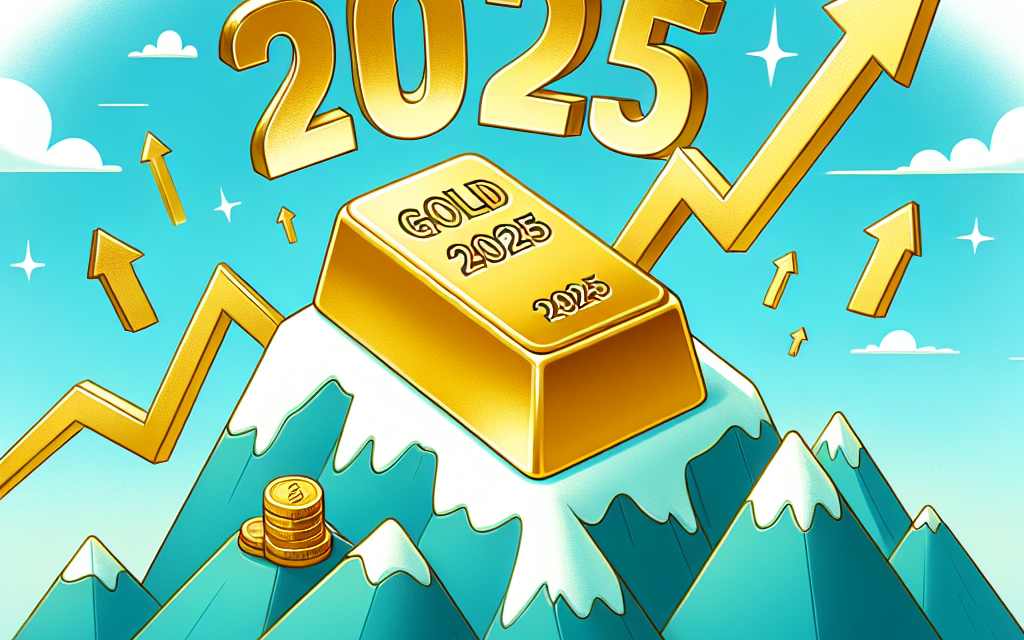“Gold Prices Set to Soar: Secure Your Future in 2025!”
Introduction
As global economic uncertainties persist and inflationary pressures continue to mount, gold prices are anticipated to climb higher in 2025. Investors are increasingly turning to gold as a safe-haven asset, seeking to hedge against market volatility and currency fluctuations. Factors such as geopolitical tensions, central bank policies, and rising demand for physical gold are expected to contribute to a bullish outlook for the precious metal. Analysts predict that as these dynamics unfold, gold could reach new heights, making it a focal point for investors looking to safeguard their portfolios in an unpredictable financial landscape.
Economic Factors Driving Gold Prices Upward in 2025
As we look ahead to 2025, various economic factors are poised to drive gold prices higher, reflecting the metal’s enduring status as a safe-haven asset. One of the primary catalysts for this anticipated increase is the ongoing uncertainty in global financial markets. Economic instability, whether stemming from geopolitical tensions, trade disputes, or fluctuating currency values, often leads investors to seek refuge in gold. Historically, during periods of economic turmoil, gold has demonstrated its ability to retain value, making it an attractive option for those looking to hedge against potential losses in other asset classes.
In addition to geopolitical uncertainties, inflationary pressures are expected to play a significant role in elevating gold prices. Central banks around the world have adopted expansive monetary policies, characterized by low interest rates and quantitative easing measures. While these strategies aim to stimulate economic growth, they can also lead to increased inflation. As the cost of living rises, the purchasing power of fiat currencies diminishes, prompting investors to turn to gold as a reliable store of value. This shift in investment strategy is likely to create upward momentum in gold prices as demand increases.
Moreover, the anticipated economic recovery following the disruptions caused by the COVID-19 pandemic may also contribute to rising gold prices. As economies rebound, the potential for increased consumer spending and investment can lead to heightened demand for gold, particularly in sectors such as jewelry and technology. Additionally, as countries strive to rebuild their economies, the potential for increased government spending could further exacerbate inflationary pressures, reinforcing the appeal of gold as a protective asset.
Another critical factor influencing gold prices is the evolving landscape of global interest rates. As central banks navigate the delicate balance between stimulating growth and controlling inflation, any indications of rising interest rates could initially lead to a dip in gold prices. However, if inflation outpaces interest rate hikes, the real yield on bonds and other fixed-income investments may remain low or even negative. In such scenarios, gold becomes increasingly attractive, as it does not yield interest but offers a hedge against inflation. Consequently, the interplay between interest rates and inflation will be pivotal in determining the trajectory of gold prices in 2025.
Furthermore, the growing interest in sustainable and ethical investing is likely to impact gold demand. As investors become more conscious of the environmental and social implications of their investments, the demand for responsibly sourced gold may rise. This shift could lead to increased premiums for ethically mined gold, further driving up overall prices. Additionally, the rise of digital gold and blockchain technology may create new avenues for investment, attracting a younger demographic that values both innovation and sustainability.
In conclusion, the economic landscape leading into 2025 is characterized by a confluence of factors that are expected to drive gold prices higher. From geopolitical uncertainties and inflationary pressures to evolving interest rates and a shift towards sustainable investing, each element plays a crucial role in shaping the demand for gold. As investors navigate this complex environment, the allure of gold as a safe-haven asset is likely to remain strong, positioning it for a significant price increase in the coming years.
Historical Trends: Gold Prices and Market Predictions
Gold has long been regarded as a safe haven asset, a status that has been reinforced by historical trends and market dynamics. Over the decades, gold prices have exhibited a tendency to rise during periods of economic uncertainty, geopolitical tensions, and inflationary pressures. This historical context provides a foundation for understanding the potential trajectory of gold prices in the coming years, particularly as we look toward 2025.
In the aftermath of the 2008 financial crisis, gold prices surged as investors sought refuge from the volatility of traditional financial markets. This trend was further amplified by expansive monetary policies adopted by central banks worldwide, which included low interest rates and quantitative easing measures. As a result, gold reached an all-time high in 2020, driven by a combination of factors including the COVID-19 pandemic, which heightened fears of economic instability and prompted a rush to secure tangible assets. The price of gold, which had hovered around $1,200 per ounce in early 2016, soared to over $2,000 per ounce by August 2020, illustrating the asset’s resilience in times of crisis.
Looking ahead, several market predictions suggest that gold prices may continue to climb higher in 2025. Analysts point to a confluence of factors that could drive demand for gold, including ongoing inflationary pressures, potential interest rate adjustments by central banks, and geopolitical uncertainties. Inflation, in particular, has emerged as a significant concern for many economies, with rising consumer prices prompting investors to seek protection in gold. Historically, gold has served as a hedge against inflation, and as inflation rates remain elevated, the allure of gold as a store of value is likely to strengthen.
Moreover, the global economic landscape is characterized by increasing geopolitical tensions, which often lead to heightened demand for safe-haven assets. Events such as trade disputes, military conflicts, and political instability can create an environment of uncertainty, prompting investors to turn to gold as a reliable investment. As we approach 2025, the potential for such geopolitical risks remains, suggesting that gold could see increased buying pressure.
In addition to these macroeconomic factors, the supply dynamics of gold also play a crucial role in shaping its price trajectory. Gold mining production has faced challenges in recent years, with many mines reaching the end of their productive lives and new discoveries becoming increasingly rare. This supply constraint, coupled with rising demand, could create upward pressure on prices. Furthermore, central banks around the world have been net buyers of gold, adding to the demand and signaling confidence in the asset’s long-term value.
As we analyze the historical trends and current market predictions, it becomes evident that gold is poised for potential growth in the coming years. The interplay of inflation, geopolitical risks, and supply constraints suggests a favorable environment for gold prices to climb higher by 2025. Investors would do well to consider these factors when evaluating their portfolios, as gold continues to demonstrate its enduring appeal as a hedge against uncertainty and a reliable store of value. In conclusion, while the future is inherently unpredictable, the historical performance of gold, combined with current market dynamics, indicates a strong possibility of rising prices in the years ahead.
The Impact of Inflation on Gold Valuation in 2025
As we look ahead to 2025, the interplay between inflation and gold valuation is poised to become increasingly significant. Historically, gold has been viewed as a safe haven asset, particularly during periods of economic uncertainty and rising inflation. This relationship is rooted in the intrinsic qualities of gold, which is often seen as a hedge against the eroding purchasing power of fiat currencies. As inflation rates continue to fluctuate, the demand for gold is expected to rise, thereby driving its prices higher.
Inflation, defined as the rate at which the general level of prices for goods and services rises, erodes the purchasing power of money. When inflation is high, consumers find that their money buys less than it did previously, prompting them to seek alternative stores of value. Gold, with its long-standing reputation as a reliable asset, often becomes a preferred choice during such times. Investors typically flock to gold as a means of preserving wealth, which in turn increases its demand and subsequently its price.
In 2025, several factors are likely to contribute to a heightened inflationary environment. Central banks around the world have implemented expansive monetary policies in response to economic challenges, including the COVID-19 pandemic. These policies, characterized by low interest rates and increased money supply, can lead to inflationary pressures as economies recover. As consumer spending picks up and supply chains continue to adjust, the potential for rising prices becomes more pronounced. In this context, gold is expected to attract more attention from investors seeking to safeguard their assets against inflation.
Moreover, geopolitical tensions and uncertainties can exacerbate inflationary trends, further influencing gold prices. Events such as trade disputes, conflicts, or political instability can lead to market volatility, prompting investors to turn to gold as a stable investment. The perception of gold as a “crisis commodity” reinforces its appeal during turbulent times. As we approach 2025, any significant geopolitical developments could catalyze a surge in gold demand, pushing prices higher.
Additionally, the growing awareness of environmental, social, and governance (ESG) factors is reshaping investment strategies. Investors are increasingly considering the sustainability of their portfolios, and gold mining practices are under scrutiny. As a result, ethical sourcing and responsible mining practices are becoming more important to investors. This shift may lead to a premium on gold that meets these criteria, further influencing its valuation in the market.
Furthermore, the rise of digital currencies and alternative investments has introduced new dynamics into the financial landscape. While some may argue that cryptocurrencies could replace gold as a store of value, the historical resilience of gold cannot be overlooked. In times of economic distress, gold has consistently proven its worth, while the volatility of digital currencies can deter risk-averse investors. Thus, even as new investment vehicles emerge, gold is likely to maintain its status as a trusted asset.
In conclusion, the impact of inflation on gold valuation in 2025 is expected to be profound. As inflationary pressures mount due to expansive monetary policies, geopolitical uncertainties, and evolving investment paradigms, gold is likely to see increased demand. This demand, driven by the desire for wealth preservation and stability, is anticipated to push gold prices higher. As investors navigate the complexities of the economic landscape, gold will remain a pivotal asset, reflecting its enduring appeal in times of uncertainty.
Geopolitical Tensions and Their Influence on Gold Prices
As we look ahead to 2025, the landscape of global geopolitics is poised to play a significant role in shaping the trajectory of gold prices. Historically, gold has been viewed as a safe-haven asset, particularly during times of uncertainty and conflict. This intrinsic value is rooted in its ability to retain purchasing power when traditional currencies falter, making it a preferred choice for investors seeking stability. In the context of escalating geopolitical tensions, the demand for gold is expected to rise, further driving up its price.
One of the primary factors influencing gold prices is the ongoing volatility in international relations. As nations grapple with issues such as trade disputes, military conflicts, and diplomatic standoffs, the resulting uncertainty often leads investors to flock to gold. For instance, tensions between major powers can create an environment of fear and speculation, prompting individuals and institutions to hedge against potential economic downturns. This behavior is not merely anecdotal; it is supported by historical trends that demonstrate a correlation between geopolitical crises and spikes in gold prices.
Moreover, the current geopolitical climate is characterized by a multitude of flashpoints that could escalate into broader conflicts. From territorial disputes in the South China Sea to the ongoing strife in Eastern Europe, these tensions are not only localized but have global implications. As nations respond to these challenges, the potential for sanctions, military engagements, or economic fallout increases, all of which can contribute to a heightened demand for gold. Investors, recognizing the potential for instability, are likely to increase their allocations to gold as a protective measure.
In addition to direct conflicts, the influence of geopolitical tensions extends to economic policies and central bank actions. For example, when countries face external pressures, they may resort to monetary easing or other measures to stabilize their economies. Such actions can lead to currency devaluation, which in turn diminishes the value of fiat currencies relative to gold. As a result, investors may turn to gold as a more reliable store of value, further propelling its price upward. This dynamic is particularly relevant in the context of the current global economic environment, where inflationary pressures and supply chain disruptions are prevalent.
Furthermore, the interconnectedness of global markets means that geopolitical events in one region can have ripple effects across the world. For instance, a crisis in the Middle East can lead to fluctuations in oil prices, which can subsequently impact economies reliant on energy imports. In such scenarios, gold often emerges as a refuge for investors seeking to mitigate risk. The anticipation of these interconnected events can create a self-fulfilling prophecy, where the mere expectation of geopolitical instability drives up demand for gold, thereby increasing its price.
As we approach 2025, it is essential to consider the broader implications of these geopolitical tensions on gold prices. The interplay between conflict, economic policy, and investor sentiment will likely create an environment conducive to rising gold prices. In this context, gold not only serves as a hedge against uncertainty but also as a barometer of global stability. As such, investors would be prudent to monitor geopolitical developments closely, as these factors will undoubtedly shape the future of gold in the coming years. Ultimately, the confluence of these elements suggests that gold prices are expected to climb higher, reflecting the enduring appeal of this precious metal in times of turmoil.
Investment Strategies for Capitalizing on Rising Gold Prices
As gold prices are anticipated to climb higher in 2025, investors are increasingly seeking effective strategies to capitalize on this upward trend. Understanding the dynamics of the gold market is essential for making informed investment decisions. One of the primary strategies involves direct investment in physical gold, which can take the form of bullion bars, coins, or jewelry. This tangible asset not only serves as a hedge against inflation but also provides a sense of security during economic uncertainty. Investors should consider purchasing gold from reputable dealers to ensure authenticity and quality, as the value of gold can be significantly affected by its purity and condition.
In addition to physical gold, exchange-traded funds (ETFs) that focus on gold can be an attractive option for those looking to gain exposure to the metal without the complexities of storage and insurance. Gold ETFs typically track the price of gold and can be traded like stocks, offering liquidity and ease of access. This investment vehicle allows investors to benefit from rising gold prices while maintaining a diversified portfolio. Furthermore, investors should pay attention to the management fees associated with these funds, as they can impact overall returns.
Another strategy worth considering is investing in gold mining stocks. These equities can provide leveraged exposure to gold prices, as the profitability of mining companies often increases significantly when gold prices rise. However, it is crucial to conduct thorough research on individual mining companies, as factors such as operational efficiency, production costs, and geopolitical risks can influence their performance. By selecting well-managed companies with strong fundamentals, investors can potentially enhance their returns in a rising gold market.
Moreover, options trading on gold can be an advanced strategy for those with a higher risk tolerance. Options allow investors to speculate on the future price movements of gold without the need to own the physical asset. By purchasing call options, investors can benefit from price increases while limiting their downside risk to the premium paid for the option. However, this strategy requires a solid understanding of options trading and market dynamics, making it more suitable for experienced investors.
In addition to these strategies, diversifying one’s investment portfolio is essential in managing risk. While gold is expected to perform well in 2025, it is prudent to balance investments across various asset classes, including stocks, bonds, and real estate. This diversification can help mitigate potential losses in case of market volatility. Furthermore, keeping abreast of macroeconomic indicators, such as interest rates, inflation, and geopolitical events, can provide valuable insights into the gold market and help investors make timely decisions.
As the global economic landscape continues to evolve, staying informed about market trends and developments is crucial for successful investing in gold. Engaging with financial advisors or utilizing investment platforms that offer research and analysis can enhance one’s understanding of the gold market. By employing a combination of these strategies—direct investment in physical gold, gold ETFs, mining stocks, and options trading—investors can position themselves to take advantage of the anticipated rise in gold prices in 2025. Ultimately, a well-thought-out investment approach, grounded in research and diversification, will be key to navigating the complexities of the gold market and achieving financial success.
The Role of Central Banks in Gold Price Increases
As the global economy continues to evolve, the role of central banks in influencing gold prices has become increasingly significant. Central banks, as the monetary authorities of their respective countries, play a crucial role in managing national currencies and, by extension, the overall economic stability. One of the key strategies employed by these institutions is the accumulation of gold reserves, which serves as a hedge against inflation and currency devaluation. This practice not only reflects a bank’s confidence in gold as a stable asset but also impacts the broader market dynamics, contributing to the anticipated rise in gold prices in 2025.
Historically, central banks have been net buyers of gold, particularly during periods of economic uncertainty. This trend is expected to continue as geopolitical tensions and inflationary pressures mount. When central banks increase their gold reserves, they signal to the market that they foresee potential economic challenges ahead. This behavior often leads to heightened demand for gold, which, in turn, drives prices upward. As central banks diversify their assets, gold remains a preferred choice due to its intrinsic value and historical role as a safe haven.
Moreover, the actions of central banks can create a ripple effect throughout the financial markets. For instance, when a central bank announces an increase in gold purchases, it can lead to a surge in investor interest, prompting private investors and institutional players to follow suit. This collective buying pressure can significantly elevate gold prices, reinforcing the perception of gold as a reliable store of value. Consequently, as central banks continue to bolster their gold holdings, the market may witness a sustained upward trajectory in gold prices.
In addition to direct purchases, central banks also influence gold prices through their monetary policies. For example, when central banks adopt accommodative monetary policies, such as lowering interest rates or implementing quantitative easing, the opportunity cost of holding gold diminishes. Lower interest rates reduce the yield on traditional investments, making gold more attractive to investors seeking to preserve wealth. As a result, the demand for gold often increases, further propelling prices higher. This relationship between monetary policy and gold prices underscores the importance of central banks in shaping market expectations and investor behavior.
Furthermore, the global economic landscape is characterized by increasing uncertainty, driven by factors such as trade tensions, political instability, and the ongoing effects of the COVID-19 pandemic. In such an environment, central banks are likely to prioritize gold accumulation as a means of safeguarding their economies. This strategic focus on gold can lead to a self-reinforcing cycle, where rising prices attract more buyers, including central banks, thereby pushing prices even higher.
As we look ahead to 2025, it is clear that the actions of central banks will play a pivotal role in determining the trajectory of gold prices. With many central banks already signaling their intent to increase gold reserves, the market can expect a sustained demand that will likely contribute to price increases. In conclusion, the interplay between central bank policies, economic uncertainty, and investor behavior will be instrumental in shaping the future of gold prices. As central banks continue to navigate the complexities of the global economy, their influence on gold will remain a critical factor for investors and market analysts alike.
Expert Opinions: Forecasting Gold Prices for 2025
As we look ahead to 2025, expert opinions on the trajectory of gold prices suggest a significant upward trend, driven by a confluence of economic factors and geopolitical uncertainties. Analysts from various financial institutions have begun to articulate their forecasts, indicating that gold, often viewed as a safe-haven asset, is likely to gain further appeal among investors. This anticipated rise in gold prices can be attributed to several key elements, including inflationary pressures, currency fluctuations, and ongoing global instability.
One of the primary drivers of gold prices is inflation, which has been a growing concern for economies worldwide. As central banks continue to implement expansive monetary policies, the risk of inflation remains elevated. Experts argue that as inflation erodes the purchasing power of fiat currencies, investors will increasingly turn to gold as a hedge against this decline. Historical data supports this notion, as gold has consistently performed well during periods of high inflation. Consequently, many analysts predict that if inflation persists or accelerates, gold prices could see a substantial increase in 2025.
In addition to inflation, currency fluctuations play a crucial role in shaping gold prices. The U.S. dollar, being the primary currency for gold transactions, has a direct impact on its valuation. Should the dollar weaken due to trade imbalances or shifts in monetary policy, gold prices are expected to rise. Experts suggest that geopolitical tensions, such as trade disputes or military conflicts, could further exacerbate this situation, leading to a decline in the dollar’s strength. As a result, investors may flock to gold, driving prices higher as demand surges.
Moreover, the ongoing uncertainty surrounding global markets cannot be overlooked. With geopolitical tensions on the rise, including conflicts in various regions and the potential for economic sanctions, investors are likely to seek refuge in gold. This trend has been observed in previous crises, where gold has served as a reliable store of value. Analysts emphasize that as long as these uncertainties persist, the demand for gold will remain robust, contributing to an upward trajectory in prices.
Furthermore, the increasing interest in gold-backed financial products, such as exchange-traded funds (ETFs), is expected to bolster demand. As more investors seek exposure to gold without the need for physical ownership, the growth of these financial instruments could lead to higher prices. Experts predict that the expansion of gold ETFs will attract a broader range of investors, including institutional players, thereby increasing overall market liquidity and driving prices upward.
In conclusion, the expert consensus on gold prices for 2025 leans towards a bullish outlook, influenced by inflationary concerns, currency dynamics, and geopolitical uncertainties. As investors navigate an increasingly complex economic landscape, gold is poised to regain its status as a preferred asset class. The interplay of these factors suggests that gold prices may not only climb higher but could also reach new historical peaks. As we approach 2025, it will be essential for investors to stay informed about these developments, as the evolving economic environment will undoubtedly shape the future of gold investment strategies. With a careful analysis of market trends and expert insights, stakeholders can position themselves to capitalize on the anticipated rise in gold prices, ensuring they are well-prepared for the opportunities that lie ahead.
Q&A
1. **Question:** What factors are expected to drive gold prices higher in 2025?
**Answer:** Economic uncertainty, inflation concerns, and geopolitical tensions are expected to drive gold prices higher in 2025.
2. **Question:** How does inflation impact gold prices?
**Answer:** Inflation erodes the purchasing power of currency, leading investors to seek gold as a hedge, which can increase its price.
3. **Question:** What role do interest rates play in gold price movements?
**Answer:** Lower interest rates reduce the opportunity cost of holding gold, making it more attractive and potentially driving prices up.
4. **Question:** Are there any predictions for gold prices in 2025?
**Answer:** Analysts predict that gold prices could reach between $2,000 and $2,500 per ounce by 2025, depending on market conditions.
5. **Question:** How do global economic conditions affect gold prices?
**Answer:** Weak global economic conditions often lead to increased demand for gold as a safe-haven asset, pushing prices higher.
6. **Question:** What impact do central bank policies have on gold prices?
**Answer:** Central banks’ decisions to buy or sell gold reserves can significantly influence market supply and demand, affecting prices.
7. **Question:** Is there a historical trend of gold prices rising during economic downturns?
**Answer:** Yes, historically, gold prices tend to rise during economic downturns as investors flock to safe-haven assets.
Conclusion
Gold prices are expected to climb higher in 2025 due to factors such as increasing inflation concerns, geopolitical tensions, and a potential decline in the value of major currencies. Additionally, central banks’ continued interest in gold as a safe-haven asset and investment diversification will likely contribute to upward pressure on prices. Overall, the combination of economic uncertainty and heightened demand for gold suggests a bullish outlook for its value in 2025.





